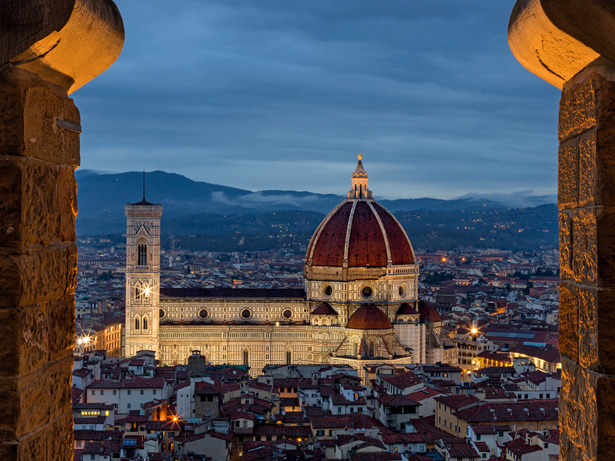Ciao!
Here is an incredible picture (that I did not take myself) of Duomo from a distance at dusk.

Today, we visited The Duomo, a major cathedral in the center of Florence. From
the ground, it is quite a sight to see, but when we climbed the cupola to the
very top, we were overwhelmed by the breathtaking view of all of Florence.
Here are two views of The Duomo from the ground - can you guess why it is called The Duomo?
Domes are amazing architectural achievements. You might be reminded of The Pantheon in
Rome from a recent blog post. Rome's Pantheon was indeed a inspiration to the Florentine people. But of
course, they wanted their dome to be even larger!
When looking at the pictures above, can you imagine how this dome
was built? Can you envision the workers putting it together piece by piece? How
did they do it? How long did it take? How did they get the materials from one place to another without modern technology?
Here is a brief explanation of the story....
Before The Duomo became The Duomo, it was the main cathedral in Florence. Unfortunately, the structure itself suffered from roof problems. The sun would beat down or the
rain would pour in through holes in the roof right on top of the high altar. This was a big problem!
In addition, the Florentine people were very proud of their lovely city –
rightly so – and wanted to have a major cathedral that would rival all others
all over the world. They decided the way they could set themselves apart was by replacing this imperfect roof with the most enormous dome possible.
The dome they’d build would have to sit on the pre-existing
cathedral which was already fairly large. There was much debate about whether
or not such a dome could be made at all. The project would be an enormous
undertaking. Eventually, a contest was announced inviting architects from far
and wide to submit their best ideas for making The Duomo a reality. The winner of the contest would be able to design and construct the dome, and at the same time likely become quite
famous (as long as the project was a success.) As you can imagine, many many Italians brought
their plans to Florence.
Filippo Brunelleschi (a genius in the making) was a clock maker/gold smith/ and overall impressive tinkerer who was always curious about the ways things worked. In the end, he won the contest with his impressive design and model. Brunelleschi spent quite a bit of time studying The Pantheon
in Rome before attempting to engineer The Duomo. His plan was to build a dome
within a dome. If you look at the picture below, you can see that he used large
white “ribs” to outline and support the dome - picture the rings around a barrel. Then he filled them in with
bricks placed in a herringbone pattern to make increase their strength. He usead about 4 million bricks in all! The entire project took about fourteen years. He had to build the dome on top of the existing cathedral that was already 180 feet high. Additionally, the dome itself was planned to be 150 feet across. WOW!!!!!!
At the tippy-top, where
all of the white “ribs” meet, he built a cupola. Mrs. Kinahan and I walked up
the narrow, twisting inner staircases (
Climbing to the cupola was amazing. So many stairs getting
steeper and more narrow as we ascended higher and higher above the city. Every
once in a while, we would come across a small window where we could peek out at
the city below. There were two stops where we could leave the staircase and walk
around inside the balconies built into the dome. Here we were able to
marvel at the enormous fresco covering the rounded ceiling.

But the highlight was getting to the top and popping our
heads out the tiny entrance onto the cupola where there was a nice breeze and
an incredible view of the city of Florence and surrounding hilly countryside.
For quite some time, Brunelleschi’s Dome was the most celebrated building in all of Italy, and it might still be. But of course, our good friend Michelangelo was following close behind. Soon after the Florentine dome was complete, he designed and constructed the dome at Saint Peter’s Basilica (pictured below). He said of The Duomo, “I’ll make its sister…bigger, but not more beautiful.” That is a pretty modest comment for a proud Italian...
Tomorrow...POMPEII!!!!!!
Arrivederci,
Mrs. Babcock








Comments
Post a Comment